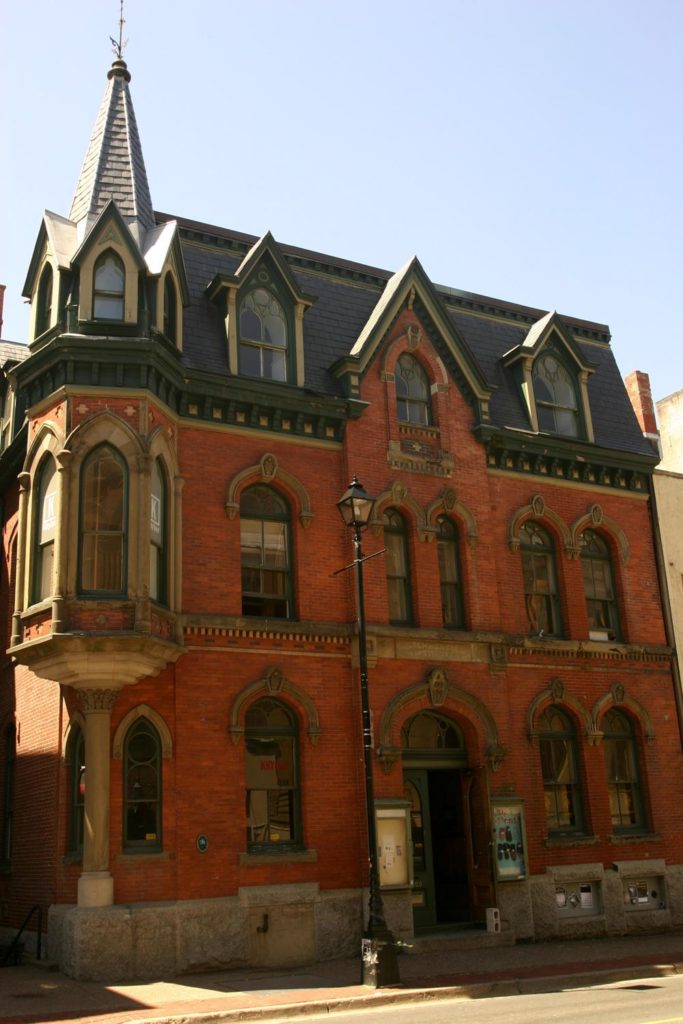Halifax City Council delayed a decision yesterday regarding the fate of the Khyber building—a heritage edifice that until recently was home to the Khyber Centre for the Arts, one of the city’s key artist-run spaces.
The delay gives the Khyber’s arts supporters until September to campaign against the possible sale of the building to private interests.
In March, the Khyber Arts Society, which managed arts activities in the building since 1995, vacated the building on what was hoped to be a temporary basis due to city staff concerns about a need for asbestos remediation.
At that time, Richard MacLellan, acting manager of facility development at the Halifax Regional Municipality, told Canadian Art via email that “In the coming months, following further assessment of the building, a report will be presented to Regional Council outlining repair options for their consideration.”
Supporters of the Khyber building as an arts and cultural incubator—a direction set by past Council decisions—were therefore surprised on Friday, July 25, when the building turned up in a general staff recommendation to Council about disposal of surplus property in the Halifax region.
In the July 25 document, city staff recommend that 18 properties ranging from former high schools and fire stations to undeveloped lots be declared surplus. Though several are suggested for sale—including five other properties to be sold at market value—the Khyber building was the only property that was designated under the city’s “Economic Development” category and recommended for sale with the partial aim of generating “financial return to the Municipality.”
“The building condition assessment has determined that this facility is in poor condition and hazardous materials have been identified,” the staff recommendation states.
City staff also note that repairs of the Khyber building are estimated at $4,150,945, while the value of the building itself is assessed at $1,357,300.
Outcry from Khyber supporters has since shot through social media.
“I met my wife at the Khyber in 1994,” Polaris Prize–nominated musician Joel Plaskett wrote on Twitter. “I’ve shot videos, recorded records and played countless shows there. If it gets sold my heart will [break].”
“I fully believe that [the Khyber building] deserves to get fixed,” artist Daniel Joyce, until recently artistic director of the Khyber Arts Society, wrote on Facebook. “It has been used as a cultural and social space for over 125 years, has been a home to some of Halifax’s best artists and people, it is a rare type of community arts space that is very specific to the Halifax experience. To invest in the Khyber is to invest in a large portion of the arts and social activity that goes on in the HRM.”
“The building is of significant historical importance: notably, over the past four decades, it has been a key site, not only for the arts, but for the Halifax Queer community, the immigrant community and a host of communities representing alternative cultural voices,” wrote Saint Mary’s University director/curator Robin Metcalfe. “In the mid-1970s it housed the community-controlled social space of the Gay Alliance for Equality, a site of historic importance not only for the Halifax Queer community, but of significance nationally and internationally.”
Halifax city councillor Waye Mason, whose district includes the Khyber building and whose past work as founder of the Halifax Pop Explosion included programming musical acts for the facility, is also dismayed by the staff recommendation.
“I think [city] staff have never been interested in investing time and money in the space,” Mason tells Canadian Art via email. “I’ve been involved with the Khyber since the early 90s on and off and this is far from the first time that the city has effectively withdrawn support. It is endlessly frustrating when it seems that Council’s motions are clear and unambiguous” in support of the Khyber building as an arts and culture incubator.
However, Mason says, it is important for the arts community to consider other options as well.
“If the building is really in such bad shape that it will cost many more millions to renovate it than to buy a new building in downtown, then we have to be realistic,” Mason states. “The Khyber as a place is important but it isn’t responsible as a community leader for me to say ‘whatever it costs we will spend it.’ The building is less than 10,000 square feet of space. What is important is the concept of an arts incubator and having an artist-run centre located in downtown. Other municipal space or other commercial space may fill that need at a more reasonable cost. But until we get some engineering studies to review the arts incubator council does not have enough information to decide.”
With the City Council decision on the Khyber as surplus property now deferred until September, it’s possible this information-gathering may now take place—or at least a longer campaign by Khyber building supporters, who are being urged to write to their city councillors in the interim.
Note to the reader: A clarification was made to this article on July 30, 2014, to indicate that five other properties suggested as surplus by city staff were designated to be sold at market value—albeit under a different category than the Khyber building. Canadian Art also requested an interview with Halifax city staff on this matter and was told one would best be arranged after City Council makes its decision.

 The top of the historic Khyber Building in Halifax, built in 1888. Photo: Martin Cathrae via Flickr/Creative Commons.
The top of the historic Khyber Building in Halifax, built in 1888. Photo: Martin Cathrae via Flickr/Creative Commons.







